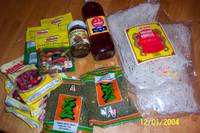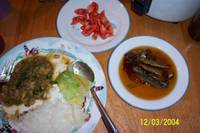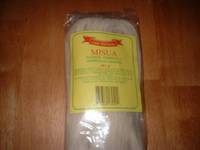This is a series of recipes (
pambawi sa katamaran ko these past days) which I included in one post since I made them all in one day a few days after I got from my sister-in-law those pork parts that she did not want which I wanted: heart, liver, small intestines, blood and lungs. A special bonus which I did not request for was the pork kidneys with its surrounding fat. I forgot to ask that the head be reserved for me. It would have been nice to have it for
sisig.
I deliberately eliminated my tendency to show step-by-step photos to avoid grossing out some readers.
************
PAKSIW NA PATA
These are dried lily buds that
stel sent to me quite a while ago (thanks a lot, blogsis!), for paksiw na pata. I used
Sassy's recipe to the letter, save for using less liquid (1/2 cup water) and adding a bit of cider (about 1/2 cup) instead of pouring water enough to cover the pork legs,


because I used the slow cooker (which would render a lot of juice from the meat, and allow very little evaporation).

Here is now the finished product. I placed some in a small jar to let my brother-in-law have a taste of it. He said it was good! (His wife, hubby's sister, would not even look at it.) At present I have it frozen.

************
DINUGUANWhile slowcooking Paksiw na Pata,

I next searched for a recipe for dinuguan. Since Sassy's used sinigang mix which I did not have at the time, I looked again and found this
Kapampangan recipe. But while the original recipe called for pork shoulder, I used the most fleshy part of pata, I retained the pork heart, I eliminated the beef tripe and replaced it with pork small intestine cut in 1-inch length after cleansing and boiling. I also retained the pork liver. Then instead of looking for green chilies I used my ground red pepper for added kick.
 Ingredients:
Ingredients:
2 tbsps cooking oil
3 cloves garlic, minced
1 onion, minced
3 lbs. pork meat, diced
1 pc pork heart, boiled then diced
1 pork tongue, boiled then diced
1/2 lb. small intestine, cleansed, boiled and diced
(Type in google search "pork intestine and you'll find the methods to do this.)
100 gms. pork liver, diced
1 cup vinegar
2 cups water
1-1/2 cups pig blood
1/4 tsp ground red pepper
salt to taste
(Note: My mother used to just have pork meat with some fat and some slices of sayote or papaya, without innards, and with some more water. Personally, I prefer this dish cooked like my mother did.)
Instructions:Those ingredients that called for boiling and dicing, you can throw all at once in a stockpost and boil for 15 minutes.
Saute garlic and onion in cooking oil.
Add diced pork, tongue, heart, liver and SI. Bring to a boil and simmer until tender.
When meat is tender, add vinegar, broth, and hot peppers and bring to a boil. Add salt.
Add pork blood stirring continuously until thick. Simmer for 5 minutes. Adjust seasonings.
My older son still recalls having had this in the Philippines, although my Mom cooked it a bit differently, adding a little sugar and thin slices of sayote. I brought some to my friend Ana's house for lunch when she fetched me to share with her the tilapia which she roasted. Hmmm...we liked it! I never let my hubby see this (and the bopis and pork kidneys), though. He'd puke for sure.
UPDATE FOR DINUGUAN:
I have just browsed stel's foodblog and eureka! She also cooked dinuguan! Wish I had her recipe before I cooked mine.
************
BOPIS
I remember when I was still a child, I used to help chop the pork
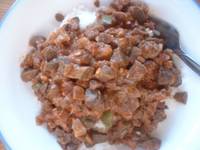
lungs after it has been parboiled. I particularly liked munching the soft lung tissue then the contrasting stiffer cartilage pieces that formed part of the bronchi and bronchioles (those smaller continuations of the windpipe). Probably there were only about 3 such events in my entire life in the PI.
For this recipe, I used Nanay Mareng's as passed on to me by stel (thanks again for that recipe!). I just replaced the tomato sauce with my homemade canned Italian-style TS, then replaced the pineapple juice with cider (I just experimented; the idea popped into my head when I was thinking of what I could possibly use since I had no pineapple juice, then suddenly I recalled that in minced deer meat, we used cider to keep the mixture moist. I figured it probably would have the same effect on dinuguan, except that it would give a twist in the flavor. It worked!). I also used frozen green bell pepper and my ground red pepper to make it a bit hot.
Once again I did not anymore include step-by-step photos because I don't want to make anybody's tummy turn topsy-turvy.
Ingredients:2 pork lungs with heart, parboiled then chopped.
1 pint tomato sauce
1 cup cider
3 cloves of garlic, chopped
1 onion, chopped
2 bay leaves
1 green bell pepper, diced
1/4 tsp ground red pepper
Instructions:Saute garlic and onions, then add meat and heart, cider and tomato sauce. Season with salt and pepper.
Bring to a simmer, and without stirring, cover and cook for 30 minutes. Add peppers amd simmer until sauce is reduced and almost dry.
This is the first time I really cooked this from start to finish, and the first time for my kids to see it. When they came home that day I offered it to them, and, having quite picked up my hubby's tendency to be paranoid with what I serve, they asked what was in it. I always try to be honest with them, so I told them that it was pork lungs, and the dish was called bopis (with matching enthusiasm to convince them). They were reluctant to taste it, saying "yuck!" in a soft tone. I was not discouraged. I placed about 3 pieces on a spoon and told them to taste it first before saying no. They did. Both of them liked it! We had it for supper before my hubby was home. Hubby had mac & cheese plus hotdogs that night. I did not tell him what we had, or he would not kiss me that night and the next day.
UPDATE: 1/17/2010
Here is a slideshow:
*************
PORK LARD
As I said above, when I finally had from my SIL the pork parts that she did not want, I was surprised with
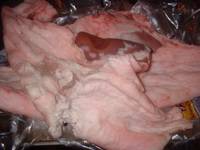
this: pork fat with the kidneys still attached. I have read in a past issue of
Cook's Illustrated that pork lard is the best for pie crust, and that it can be derived from the fat surrounding the kidneys, but other fatty parts can also be used. However, there was no procedure given for that (making lard) since the topic was about pie crusts. So I searced again my virtual library and found a procedure for it
here. It was quite simple.
In quest for a kind of shortening that was nearest to its natural state, and having been exposed
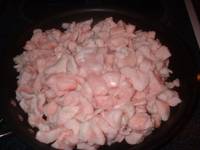
to my
Nanay who used to render fat from the skin of pork or chicken to sautee spices or meat, I ventured into this unfamiliar territory (I imagine this might be done quite frequently by the Filipinos whose business is raising and selling swine).
I cooked it over low heat to avoid getting to the smoking point (at which point it will be oxidized). Before making this post, I had to ask
Fanatic, a nutritionist, about her opinion on pork lard, and here's what she told me:
My opinion about pastry ... there's nothing better than lard for making
pastry (with a little butter for flavor). Lard is almost 100 percent fat, where
butter is only about 80 percent fat, the other 20 percent is protein and
moisture. Butter's moisture (water) makes it a poor choice for pastry (when used
exclusively), since water will form gluten when it comes in contact with flour
... making the final product chewy instead of flaky.
I stay away from vegetable shortening. Even though it has about the same
fat content as lard (making flaky pastry), the trans fatty acids from the
process of hydrogenation are now supposedly more of a health concern than the
saturated fat in lard. Shortening is pretty tasteless too.
The lard I can purchase here, believe it or not, is hydrogenated. It also
contains BHA and BHT (known carcinogens) as preservatives. It's hardly a product
I would consume. You deserve a pat on the back for rendering your own lard!Just
yesterday I purchased a new product. It's an organic non-hydrogenated
shortening, made from palm oil. Palm oil is very saturated naturally, so it's
more solid at room temperature.
Another benefit of using animal fat (lard) for use in cooking ... it has a
high smoking point so you can brown with it and it will not break down
(oxidize). Most vegetable-based liquid oils cannot be exposed to high
temperatures without oxidizing, and oxidized (rancid) fat is carcinogenic. And
as your Nanay says ... fresh lard tastes better. I think you need to weigh the costs and
benefits of the fat you plan on using.In the end, as long as you eat in
moderation and are relatively active in life, I don't believe small amounts of
animal fat are deleterious .
Nakahinga ako nang maluwag...It's good to hear those words from one with authority on the subject matter. I mean, yeah, I have my opinions on some food products, with my understanding of how the human body metabolizes the major chemicals we get from foods. But food and food processing itself are things made complicated by the "more civilized" people. "Medical studies" and business interests, plus the government's tendency to appease the public make things more complicated and puzzling that the obvious seems obscure. Anyway, you can check out her organic non-hydrogenated shortening for a healthier option in making pie crusts if you can't make your own lard.
As instructed, I continuously transferred the rendered fat (liquid lard) into clean dry jars as available, straining it first.
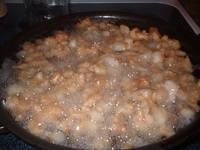
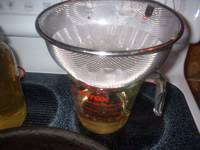
I made a mistake of waiting a little bit further after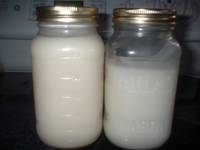 getting about half of the liquid fat (aka oil), because it turned a bit more brown when there was no more to melt. Hence here you can see the jars containing lard with different colors. I use the whiter lard for pie crusts, and the brownish lard for deep frying. I keep these jars in the fridge as directed. The white lard had almost no smell, only a hint of sweetness. It really works great with pies! The brownish lard had that distinct but subtle pork fat scent. I used it to make french fries (Fries always give my kids and hubby a thrill. They feel like they are eating at a restaurant.)
getting about half of the liquid fat (aka oil), because it turned a bit more brown when there was no more to melt. Hence here you can see the jars containing lard with different colors. I use the whiter lard for pie crusts, and the brownish lard for deep frying. I keep these jars in the fridge as directed. The white lard had almost no smell, only a hint of sweetness. It really works great with pies! The brownish lard had that distinct but subtle pork fat scent. I used it to make french fries (Fries always give my kids and hubby a thrill. They feel like they are eating at a restaurant.)

************
PORK KIDNEY "à la douaisienne"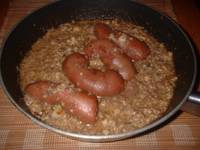
The last unwanted pork part that I cooked was the kidneys. It was my first time actually, and I found this
French recipe and tried to follow it to the letter, save for the step that called for flambe/Cognac. I did not know how to flambe and I had no flame on my stove. Neither had I Cognac. There were no proportions in the ingredients list, so I approximated.
When I tasted it, it was yummy, though the dish was very unfamiliar. The kidney itself reminded me that I already had a taste of this, usually with a kind of dish that was like tinola and the name of which I don't know. I only had it from karinderias. I also vaguely remember having bits of this in
Batchoy (the original I tasted in Miag-ao, Iloilo during field zoology in college, seasoned with
toyomansi)
.Ingredients:2 pork kidneys
1/2 c Breadcrumb
3 cloves Garlic, minced
1 tbsp Parsley, minced
1/2 cup Milk
1 Egg
Enough water to keep moist
Instructions:Kidneys should be cleaned carefully to avoid any unpleasant taste.
Prepare the stuffing by dipping the breadcrumb into the beaten egg mixed with milk. Incorporate the chopped garlic and parsley in the preparation (in reasonable quantity). The stuffing should be wet but keep a good consistence.
Stuff kidneys and tie them up. In a pot, brown the kidneys in butter on strong fire. Without forgetting either the salt or the pepper, pour enough stock (or even water) to obtain an averagely thick sauce (that can be thickened with flour). This sauce will later be used as dressing on the boiled potatoes that will be served as vegetables. Do not hesitate to cook the remaining stuffing in the sauce. Slow cook for half an hour, stirring frequently to avoid scorching.
I was the only one who tasted it (my kids preferred the
dinuguan. I could not offer it to hubby; it would freak him out for sure!

 Mix and sift dry ingredients.
Mix and sift dry ingredients. oven for 5 to 10 minutes until golden brown.
oven for 5 to 10 minutes until golden brown. 













